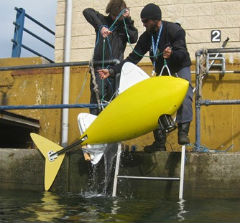Robo-fish sniff out marine pollution
 There’s a new species of fish swimming through the Spanish port of Gijon and researchers are paying it close attention.
There’s a new species of fish swimming through the Spanish port of Gijon and researchers are paying it close attention.Rather than unknown wildlife, however, the breed in question is entirely robotic. The “fish” are a man-made invention designed by a consortium of businesses and universities to detect pollution in the port and relay information back to scientists.
The SHOAL robots, which cost approximately $31,600 each and are about five feet long, are equipped with chemical sensors that can pick up pollutants like lead and copper. The robots swim independently but work together to send their data back to shore.
Because the machines provide real-time in-situ analysis, responders can react immediately to any cause of pollution such as a leak or spillage. If the system is successful, it would be a huge improvement to current diver-based methods of water monitoring that are both costly and time-consuming, New Scientist reports.
“The idea is that we want to have real-time monitoring of pollution, so that if someone is dumping chemicals or something is leaking, we can get to it straight away, find out what is causing the problem and put a stop to it,” Luke Speller, leader of the SHOAL project, told BBC News.
The robots were designed to blend in with other marine life, but that’s not the only reason for their fish-like appearance. The tails of the fish allow the machines to make tight turns that otherwise wouldn’t be possible with propeller-driven robots. The fin also cuts down on noise pollution, lessening the robots’ impact on their surroundings.
You can return to the main Market News page, or press the Back button on your browser.

